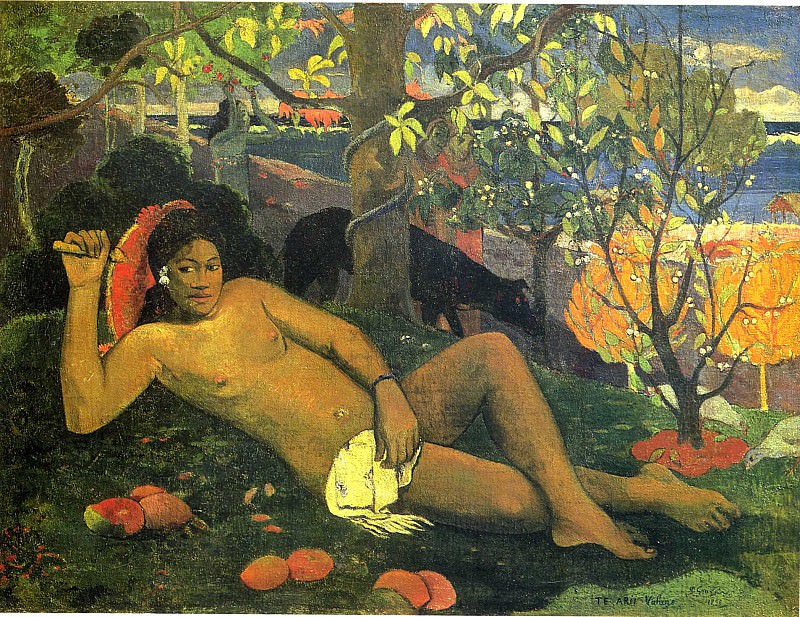Gauguin (19) Paul Gauguin (1848-1903)
Paul Gauguin – Gauguin (19)
Edit attribution
Download full size: 1906×1469 px (0,4 Mb)
Painter: Paul Gauguin
Paul Gauguin, son of a French journalist and a Peruvian Creole from a wealthy family, spent his childhood in Peru with his mother’s family. The bright costumes of the native inhabitants of South America, the looseness of their behavior, and the unusual nature were the first impressions of the future painter’s childhood and partly shaped his inner world, giving him a positive charge for life. After finishing school and the Naval School in France, having successfully created a family, amassed a fortune and traveled the world, Paul nevertheless felt a strong attraction to exotic places - like the one where he spent his childhood. Gauguin called civilization and all its signs "a disease.
Description of Paul Gauguin’s painting "The King’s Wife"
Paul Gauguin, son of a French journalist and a Peruvian Creole from a wealthy family, spent his childhood in Peru with his mother’s family. The bright costumes of the native inhabitants of South America, the looseness of their behavior, and the unusual nature were the first impressions of the future painter’s childhood and partly shaped his inner world, giving him a positive charge for life. After finishing school and the Naval School in France, having successfully created a family, amassed a fortune and traveled the world, Paul nevertheless felt a strong attraction to exotic places - like the one where he spent his childhood.
Gauguin called civilization and all its signs "a disease. The first trip to Tahiti gave the weary man everything he lacked in the civilized world. Returning to France, he brought with him more than eighty paintings, but without success and recognition, he returned to Polynesia. Paul Gauguin became the first artist in Europe to renounce realism in favor of primitivism and naive painting in order to become closer to nature.
The King’s Wife was painted by Gauguin during his second trip to Tahiti and is one of the artist’s most significant works. This canvas is an open challenge to the European tradition of painting and perhaps even a kind of mockery of it. The pose of the beautiful Tahitian woman exactly repeats the pose of Olympia from Manet’s painting of the same name and partially copies Titian’s Venus of Urbino. Gauguin, however, does not fix the viewer’s attention on one particular myth, filling his subject with multiple signs and symbols.
In the background we can see the tree of knowledge (the tree of good and evil), which is a direct reference to the Old Testament, and the conversing elders, barely visible in the shadow of the trees. The Tahitian Eve prepares to taste the fruit that will give her knowledge-the bright red fruit lies at the girl’s feet, the young maid picking fresh fruit from the branches. In the features of the woman in the portrait we can guess Tejura, Gauguin’s wife - thus, portraying her as Eve, he sees himself as Adam.
In favor of the version of the portrait of the artist’s wife speaks a large red fan in the hand of the Tahitian woman - Paul had already depicted Tehura with this fan, which is most likely her favorite accessory. Significant and the name of the picture - calling his wife queen, the artist imagines himself a royal face, the king of painting or the white king of Tahiti. In addition, the creator consciously simplifies the forms, as far as possible - as opposed to "Olympia" and "Venus of Urbino" with their detailed, thoroughly painted bodies, Gauguin draws his beloved as a child would draw a naked woman.
The absence of any bashfulness, the celebration of the beauty of the naked body is a characteristic feature of Gauguin’s late portraits. Going to Polynesia with a "one-way ticket", he openly protested against all civilization and admired the naturalness and naivety of the natives, who know no sense of shame. This behavior of the natives reminded the creator of the primordial biblical paradise - and Tahiti he considered the true paradise on Earth. Small details of the painting also speak in favor of the Old Testament version. "Trees in bloom, a dog guarding, two doves cooing on the right," the author wrote of his creation. "The King’s Wife" demonstrates the amazing unity of man with nature. Bright, juicy colors evoke a sense of tropical heat, the eternal equatorial summer. Gauguin shows the viewer a world that has not been touched by evil and over which civilization has no power.
Кому понравилось
Пожалуйста, подождите
На эту операцию может потребоваться несколько секунд.
Информация появится в новом окне,
если открытие новых окон не запрещено в настройках вашего браузера.
You need to login
Для работы с коллекциями – пожалуйста, войдите в аккаунт (open in new window).




















You cannot comment Why?
The title of the painting, Te Arii Vahine (The Chiefs Wife), suggests a subtext of royalty or high status. The womans reclining pose, her adornments (a flower in her hair, a bracelet), and her direct gaze evoke a sense of calm power and perhaps a veiled sensuality. Gauguins use of bold colors and flat forms, characteristic of his Tahitian period, aims to convey a primitive and spiritual essence, moving away from Western realism. The idyllic setting and the presence of fruit might allude to a paradise or a lost Eden, while the viewers presence is acknowledged by the direct gaze, creating an intimate and slightly unsettling connection. The painting can be interpreted as an exploration of exoticism, femininity, and a romanticized vision of indigenous life, viewed through the lens of the Western artists subjective experience.